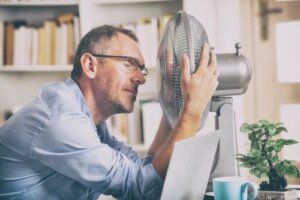Thermal Stress and its Effects on the Body

There are numerous cases of sick leave due to thermal stress. This doesn’t just occur in countries like Spain. In fact, cities like Berlin and Paris have experienced temperatures of up to 42 degrees Celsius. In addition, experts predict that temperatures are set to continue to rise.
Changes in environmental temperature affect body temperature and can lead to thermal stress. Thermal stress is the build-up of heat in the body.
The human body should maintain a constant temperature of approximately 37 degrees Celsius. Depending on the time of day and amount of physical activity, a fluctuation of less than one degree is acceptable. However, a change of more than one degree in body temperature occurs only in cases of illness or when the body can’t withstand the conditions of the environment, as is the case with extreme heat.
Thermal stress: the body’s reaction to environmental temperature
Thermal stress is a build-up of heat in the body that alters normal body temperature. If a person can’t cool their body via perspiration, they become susceptible to severe heat disorders. In addition, working at high temperatures poses a real health and safety risk. In fact, it can lead to a fatal heatstroke.
As the room temperature rises, so does the individual’s body temperature. Then, their body responds by increasing blood flow and causing their sweat glands to function. Additionally, their body increases the speed at which it loses heat to reduce its thermal load. However, in severe cases, heat gain exceeds loss and increases body temperature. This poses certain health risks.

Factors that cause thermal stress
- High humidity.
- An intensely physical job.
- Not being used to working in extreme heat.
- Insufficient breaks.
- Dehydration.
- Poor working conditions.
- Inadequate ventilation.
- Working in direct sunlight and insufficient shade.
- Working close to heat-emitting appliances. For example, vacuum cleaners, computer modems, etc.
What to do to avoid it
- Ensure adequate ventilation.
- Turn on a fan to cool the air. However, if the temperature exceeds 35 degrees Celsius, fans do more harm than good.
- Provide shaded areas for outside work.
- Provide enough fresh water for employees.
- Implement extra breaks and short work cycles.
- Carry out physically demanding work in cooler hours.
- Turn off any heat-generating devices when not in use.
- Don’t allow pregnant workers to perform physically demanding work.
- Train workers to recognize and prevent thermal stress.
- Call a doctor if a worker feels sick, dizzy, nauseous, weak, or experiences skin irritation or vision problems.
- Protect or insulate hot surfaces in workplaces.
- Provide air conditioning.
- Implement a gradual acclimatization process for all employees working in high temperatures.
The effects of thermal stress
Heat rashes (miliaria) are one of the most common effects of thermal stress. They’re tiny red bumps on the skin accompanied by tingling. These rashes occur when excessive sweat can’t evaporate. This heat-induced irritation usually decreases when the person moves to a cooler place. Furthermore, people can prevent these eruptions by wearing clothes that allow sweat to evaporate.
Heat exhaustion often occurs when people aren’t acclimatized enough to work in high temperatures. For this reason, their reactions become slower and they find it hard to concentrate. Consequently, they should remove themselves from the warm environment to avoid the condition from worsening.
Heat cramps usually occur after intense physical exertion in a hot environment. They’re caused by dehydration. Therefore, when working in high temperatures, people should drink water at least every 15 minutes or so. In addition, they should also avoid tea, coffee, alcohol, and soft drinks. Heat exhaustion causes headaches, nausea, dizziness, blurred vision, weakness, and excessive thirst.

Heat syncope
This is an extremely serious condition that can lead to fainting or loss of consciousness. It’s caused by a lack of oxygen in the brain and a lack of blood flow to the extremities. Furthermore, it happens with little or no notice.
Heatstroke occurs when body temperature reaches dangerous levels. This is due to the failure of the body’s internal regulation system. People urgently require medical intervention in these cases.
Symptoms of heatstroke include confusion, irrational behavior, loss of consciousness, seizures, hot dry skin, lack of sweating, and abnormally high body temperature.
All cited sources were thoroughly reviewed by our team to ensure their quality, reliability, currency, and validity. The bibliography of this article was considered reliable and of academic or scientific accuracy.
- Institut Valencià de Seguretat i Salut en el Treball – INVASSAT (2014). Medidas preventivas para el trabajo en épocas de altas temperaturas. Normas e instrucciones de actuación GENERALITAT VALENCIANA. Conselleria d’Economia, Indústria, Turisme i Ocupació.
- Nunneley, Sarah A. “Prevention of Heat Stress” in 42. Heat and Cold, Vogt, Jean-Jacques, Editor.
This text is provided for informational purposes only and does not replace consultation with a professional. If in doubt, consult your specialist.








